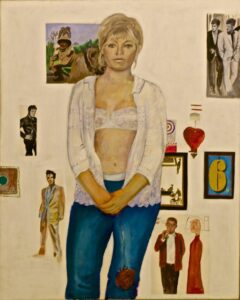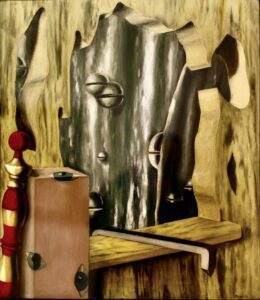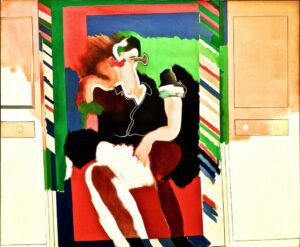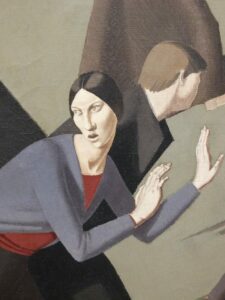The Young British Artists, or YBAs, stormed the art scene in the late 1980s with their bold, provocative works.
They’ve reshaped the landscape of contemporary art, infusing it with a mix of controversy, innovation, and market savvy.
We’ll jump into how they became a defining force, shaking up galleries and auction houses alike.
Stay tuned as we explore the key figures and seminal works that made the YBAs synonymous with a new era in British art.
Origins Of The Young British Artists
The roots of the Young British Artists (YBAs) can be traced back to Goldsmiths College in London, where a charismatic tutor named Michael Craig-Martin was known for his challenging approach to teaching art.
It was in this creative hothouse that students were encouraged to think outside the traditional constraints of their mediums and explore the conceptual possibilities of contemporary art.
In 1988, the pivotal show Freeze – organized by then-student Damien Hirst – brought together a group of Goldsmiths graduates.
This exhibition is widely regarded as the ignition point for the YBA movement, showcasing works which encapsulated the group’s ethos.
With little more than raw vision and collective ambition, they transformed a disused warehouse in London’s Docklands into an art event that caught the attention of collectors, galleries, and the media alike.
What set the YBAs apart was not only their innovative approach to art but also how they manipulated media and marketing to broadcast their work.
They understood the power of spectacle and controversy to generate buzz, which in turn propelled their careers to exceptional heights.

The group included notable figures such as:
- Tracey Emin,
- Sarah Lucas – Jake & Dinos Chapman.
Each artist brought their own unique perspective, contributing to the group’s diverse yet cohesive voice that challenged conservative aesthetics and questioned the role of art in society.
Their use of everyday materials and the incorporation of mundane or shock elements into their art confronted audiences, provoking dialogues that would shape the future of contemporary art.
As the YBAs continued to evolve, their impact expanded beyond the UK’s borders.
They began to play with larger installations, photography, and even film, making their mark across various creative industries.
Not just artists, they became cultural icons, symbols of a brash, irreverent Britain that was redefining itself as a hub of modern creativity.
https://youtube.com/watch?v=wlxLdyldYNA
The Impact Of The Ybas On The Art Scene
The Young British Artists, famously referred to as the YBAs, left an indelible imprint on contemporary art with their audacious approaches.
These artists shattered the confines of traditional art forms, paving the way for innovative expressions that redefined the 1990s.
The YBAs’ influence stretched from the galleries of London to art scenes across the globe, marking a shift towards a more open, dynamic, and media-savvy artistic environment.
The legacy of the YBAs is apparent in the art market’s evolution.
Art auctions began to buzz with a new energy as works by Damien Hirst and Tracey Emin fetched staggering sums, altering perceptions about the value and viability of contemporary art.
The advent of Charles Saatchi’s Sensation exhibition propelled the movement, highlighting the YBAs’ knack for generating controversy and commanding public attention.
- They pushed the boundaries of material usage,
- They employed shock tactics to engage audiences,
- They leveraged their persona as part of the artwork.
Our exploration of modern creativity owes a significant nod to the YBAs’ penchant for interdisciplinary practices.
Subverting norms, they embraced film and photography, often blurring the lines between artistic mediums.
Films directed by Steve McQueen, for instance, carry the torch of the YBA ethos, challenging audiences and critics to engage with moving images as a potent form of contemporary art.
The YBAs’ cultural impact also extended to their method of presentation.
Frequent collaborations with fashion designers and musicians highlighted the seamless blend between visual arts and popular culture.
Their approach mirrored a shift in society, where image and brand became integral to public and personal identity.
Simply put, the YBAs did not just inhabit the art world – they expanded its reaches into realms previously unimaginable.
Controversial Works That Defined The Movement
The Young British Artists are synonymous with provocative and pioneering art.
Throughout the 1990s, several key works became emblematic of their daring spirit.
My Bed by Tracey Emin, a candid installation of her disheveled bed complete with stained sheets and detritus, challenged conceptions of what could be considered art.
Similarly, Damien Hirst’s The Physical Impossibility of Death in the Mind of Someone Living, featuring a preserved shark in a tank of formaldehyde, left viewers grappling with themes of death and the impermanence of life.
These artists employed shock tactics not merely for attention but also to compel viewers to confront the core truths of existence.
Sarah Lucas’s Two Fried Eggs and a Kebab toyed with the viewer’s gaze and societal attitudes towards the female body.
Marc Quinn’s self-portrait Self – a frozen sculpture of the artist’s head made from his own blood – raised questions about identity and the essence of self-portraiture in art.
The YBAs didn’t shy away from leveraging their personal lives for their art:
- Emin’s Everyone I Have Ever Slept With 1963–1995 was a tent appliqued with names,
- Hirst’s art often contemplated mortality, encapsulating life and death within formaldehyde enclosures,
- Jake and Dinos Chapman’s Hell forced a stark confrontation with human cruelty through miniature dioramas.
Film and photography became essential mediums for the YBAs, further expanding their artistic vocabulary.
Sam Taylor-Johnson’s Brontosaurus captured the singular movement of a dancer, paused in a moment that felt almost serendipitous within the continuity of film.
Steve McQueen’s Hunger explored the language of cinema to jump into historical narratives, blurring the lines between film, sculpture, and installations.
Through these innovative approaches, the YBAs etched a lasting imprint on both the art and film industries, elucidating the potential of visual arts as a multifaceted tool for storytelling and cultural commentary.
Exploring The Key Figures Of The Ybas
The hallmark of the Young British Artists movement wasn’t just its radical approach to art but also the pronounced personalities that drove it.
Among these pioneers, Damien Hirst stood at the vanguard, his works such as The Physical Impossibility of Death in the Mind of Someone Living encapsulating the movement’s confrontational ethos.
Hirst’s role in organizing the seminal Freeze exhibition in 1988 is often hailed as the genesis of the YBA phenomenon.
Tracey Emin carved her own space in the art world with intimate and provocative pieces.
My Bed, displaying the raw aftermath of her personal life, challenged preconceived notions of art and garnered as much notoriety as acclaim.
Emin’s unabashed exploration of her private experiences paved the way for a more confessional art style.
Here are several other key YBA figures who each brought something distinctive to the table:

- Rachel Whiteread – Known for her sculptures that cast negative spaces, creating a poignant exploration of memory and absence.
- Sarah Lucas – Her brash and irreverent works often used found objects to probe themes of sex, death, and Englishness.
- Marc Quinn – His self-portrait Self consisting of his frozen blood pushed the boundaries of self-exploration and the fragility of life.
The YBAs collectively forged a path that intersected various mediums and practices, insisting that video and film were as legitimate as canvas and bronze.
Sam Taylor-Johnson (then Sam Taylor-Wood) brought expressive narratives to life through her film work, advancing the filmic conversation within the art sphere.
Our fascination with the YBAs is rooted not only in their radical reinvention of art but also in their ability to evolve continually.
These creators didn’t confine themselves to galleries and canvases; they ventured into the public consciousness, ensuring that their messages resonated beyond the walls of traditional art spaces.
Their boldness set the stage for the interconnected realms of art, fashion, film, and popular culture.
The Legacy And Influence Of The Ybas
The impact of the Young British Artists can’t be understated – their influence reverberates throughout the art world and beyond.
Not only did they revolutionize contemporary art, but they also left an indelible mark on adjacent industries.
Their footprint can be seen most prominently in the way current art practitioners approach the creation and dissemination of their work.
Their efforts reshaped the public’s perception of art, challenging audiences to engage with more than just the visuals.
Beyond the realm of painting and sculpture, the YBAs paved the way for new forms of expression through various media, especially film.
Their fusion of video art with narrative filmmaking opened doors for later artists to explore similar cross-disciplinary ventures.
- Cross-disciplinary Collaborations – Artists today continue to bridge gaps between artistic mediums, pulling from the YBAs’ playbook to collaborate across fields like fashion, music, and performance. – Art Market Dynamics – The boldness of YBAs has encouraged many galleries and collectors to take risks on unconventional artworks, forever altering the economics and appetite of the art market.
The YBAs also challenged the
They asserted their personas as part of the artistic oeuvre, much like filmmakers adopt signature styles or themes.
Their approach has encouraged contemporary artists to embrace a more holistic view of their work – where the artist’s identity and narrative play a pivotal role in how art is conceived and received.
Thanks to the deft incorporation of film and video, the YBAs didn’t just capture moments or craft experiences; they wove stories that could exist simultaneously in and out of traditional gallery spaces.
This storytelling aspect, akin to the narrative power of cinema, created a new dialogue between artwork and audience, one that invites participation, interpretation, and even confrontation.
By expanding the artist’s toolkit with film and video, the YBAs effectively gave birth to hybrid practices that have become standard in both the art and film industries.
Their legacy is a world where the artistic medium is limitless, the role of the artist is multifaceted, and the audience’s engagement with art is profoundly interactive.
Young British Artists – Wrap Up
We’ve seen the Young British Artists redefine the cultural landscape with their daring and innovative practices.
Their work has not only reshaped the art scene but also influenced how we perceive and interact with art today.
They’ve shown us that art can be a powerful conversation starter pushing us to question our surroundings and the status quo.
Their enduring impact is evident as new generations of artists draw inspiration from the YBAs’ fearless approach to creativity and self-expression.
The YBAs have left an indelible mark on the art world and their spirit continues to inspire a dynamic and ever-evolving dialogue within the creative community.
Frequently Asked Questions
Who Are The Young British Artists (ybas)?
The Young British Artists (YBAs) were a group of avant – garde artists who emerged in the late 1980s to become prominent figures in the 1990s art scene in Britain.
They became known for their innovative and often provocative works that challenged traditional art forms.

How Did The Ybas Influence Contemporary Art?
The YBAs influenced contemporary art by pushing the boundaries with their audacious and sometimes shocking approaches.
They were pivotal in expanding art into new mediums, collaborating across disciplines, and transforming the engagement between the audience and the art world.

What Are Some Controversial Works By The Ybas?
Some controversial works by YBAs include Tracey Emin’s My Bed, which featured an unmade dirty bed with personal items, and Damien Hirst’s The Physical Impossibility of Death in the Mind of Someone Living, which displayed a shark preserved in formaldehyde.
How Did The Ybas Use Film And Photography?
The YBAs utilized film and photography not just as tools for documentation, but as essential mediums for their artistic expression.
They incorporated these forms into their art to expand their creative vocabulary and to establish a new dialogue with their audiences.
Who Were The Key Figures Of The Ybas?
Key figures of the YBAs include artists like Damien Hirst, known for his formaldehyde animals, Tracey Emin with her personal narrative works, Rachel Whiteread with her casts of negative space, Sarah Lucas for her assemblages, Marc Quinn, and filmmaker Sam Taylor-Johnson.
What Lasting Impact Did The Ybas Have On Art?
The lasting impact of the YBAs on art is evident in the blurring of lines between different artistic mediums and the way current artists approach the creation and exhibition of their work.
They pioneered new forms of expression and altered the art market’s economics and appetite.


